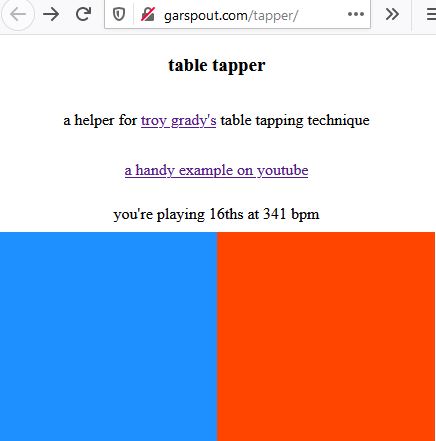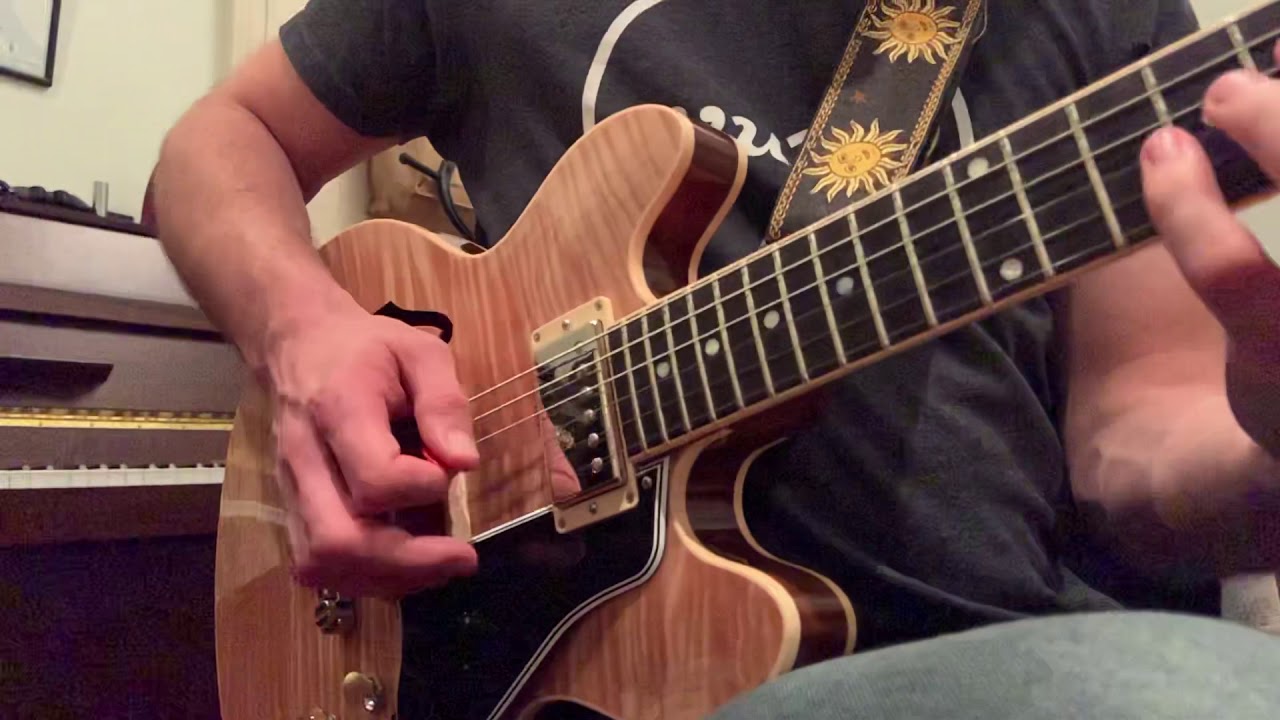Yes, its the unreasonable reasonable rule of thumb! What I’m doing is very innefficient and not the motion I do when doing a tremolo, but it seems to push my hand into being very engaged - ‘over-egging the pudding’ so to speak so that when I start picking the string, my usual picking motion comes in and it feels easy. The question is - is this just a more relaxed version of my usual motion, or have I blended them, thus tweaked my motion?
Sorry for the confusion, but the fast motion in your clip already goes up in the air on a diagonal, and your arm is not pronated. If you were to try to turn your arm toward pronation, the pick would go even more vertical, basically straight up and down. The only way that would not happen is if, in addition to pronating your arm, you also changed the wrist motion to be a different one. Is that what you’re doing? And you’re saying that’s also “hyper tap”-fast? If so post a clip, that would be interesting to see.
The eighth-note pulse is definitely how I keep track of this. Although, notably in my case it’s not the downstroke, it’s the upstroke, because that’s how I’m starting this. But really, what is a downstroke or an upstroke? The way I’m doing this, the upstroke is the trapped stroke so it feels just like doing a downstroke rest stroke with USX.
Either way, to your point, feeling an 8th note pulse may be the way that these really fast motions are timed, at least at first. Any picking speed you can think of, even 300bpm, is still slow enough to feel 8th notes pretty clearly.
But the pulse itself is not enough to achieve these kinds of speeds. There is definitely some change to the motion itself that enables this. Were you not able to move at 220 prior to this, or you never really tried?
Short answer is no, I couldn’t.
Longer answer:
I do try 200+ regularly enough to know that I struggle from that point onward!  220, I’ve never really managed to do with any degree of consistency. That being said I have recently lowered the bar of what I consider acceptable as a tremolo - if approx 80% of it is in time then I consider it achieved in raw speed terms - stops me obsessing and keeps me trying different speeds.
220, I’ve never really managed to do with any degree of consistency. That being said I have recently lowered the bar of what I consider acceptable as a tremolo - if approx 80% of it is in time then I consider it achieved in raw speed terms - stops me obsessing and keeps me trying different speeds.
If you’re able to go faster than prior, it may be that the tapping (virtual or otherwise) is helping you idenitfy better / easier motion, as it seems to have in my case. By all means keep experimenting.
When you say “in time” do you mean trying to reign in the motion so that it synchornizes with an external click source? Because if that’s the case I agree that it’s not super relevant and often counterproductive if it causes you to do weird tensing up or intentional slowing down to stay in synch. This is really about achieve maximum smoothness by feel, not trying to play along with a song or something.
Evenness of time is also kind of a moot point. Super fast tremolo doesn’t usually vary much in speed.
Are you saying you can actually do the hyperpicking motion? I gather you have no immediate death metal plans, but that’s a very cool skill and is useful even in atmospheric indie band and classical tremolo situations.
@Troy, apologies for the lack of clarification.
The points in my prior post were mainly with regards to my conventional speed picking form, not hyper picking. This is demonstrated in the video below, albeit pretty rough and quickly recorded.
I hope that clears it up a bit. Skip to the end to see the sharp pronation on the lowest string I mentioned.
I assume that’s what it is. I’m not exactly sure…it feels more like a shaking or vibration thing…there used to be a ton of tension in the elbow when I’d do it, but now not so much. It’d be nice if I could get it to cross strings smoothly. I could do some black metal with it, but I just look silly in face paint and cold, snowy weather really messes with my asthma.
I planned on doing just that at some point soon. As for its speed? If I can get the pick aligned to the string right, it’ll go too fast to decern notes, definetly too fast to synchronize anything. I rarely have the metronome out, so I cant say exact speeds. The superfast stuff is sporadic. Lately I’ve been trying to use more of a wrist motion, which was also default DSX, but trying to get it to play 3nps. I kept swiping on the USX motions. Yesterday, I decide to turn the arm so the motion becomes USX, and now I can play it without swiping…like its easier for me to transition to the single dsx from usx than it is to go from a primary dsx to usx. Id forgot how awesome it feels to just have something finally work.
@Troy
I think there’s a very important experiment that needs to be conducted. How long will it take you to find a smooth tremolo with your left hand  .
.
I’m a dummy, and don’t know how to operate our forum! Which experiment are you referring to?
I just thought that it would be interesting to check how long would it take for an expert player like you who also has all the knowledge about the motions and tons of experience in learning them through experimentation to learn to play a single note tremolo with the fretting hand.
I’ve actually tried that recently. We talked about that in another thread, I forget where. I could do wrist motion right away. Which is interesting because I had to “learn” wrist motion with my picking hand. But with the left hand, it’s the only motion I could do. In fact I couldn’t do any kind of forearm motion at all, even deliberately.
Linking up the hands was super weird. Trying to fret anything with my right hand causes the picking motion to just freeze. Which isn’t that unusual in the early stages of learning new motions, and we’ve seen this in clips here on the forum.
I like the left-handed test because it reminds me of what beginner-ness feel like, and what challenges completely new players will possibly encounter. I don’t know if I’ll continue with lefty playing, there are only so many hours in a day. But it’s cool to mess around with.
Hi all - I made a little web thing to test your table tap speed. It’s barely functional, but it’s functional. Desktop only for now, so let’s get those mouses wiggling!
If it’s actually useful to people, I’d be happy to fix it up a bit.
Pretty interesting. It seems to read pretty instantaneously, like it reports for every two crossings. Might be good to average over a larger number of crossings to get more stable results.
For example:

I was even getting in the upper 400s at some points. But not for very long.
On the other hand, I sometimes found my mouse migrating to one side or the other and not registering strokes at all, so averaging over too many crossings might be problematic. I ended up making the window as thin as possible and moving it all the way the left side of my screen so that the motion was constrained by the edge. That helped some. There’s probably a software solution as well. Some way to keep the cursor constrained to the blue and red section while testing or something?
A very nice MVP, though. I can see it being very useful.
I find that I end up doing a rotator cuff movement when I try to go as fast as possible. I wonder if this is what accounts for @Troy’s “stupid-fast” speeds? I think I recall that rotator cuff involvement is suspected in the Zakk Wylde ‘mystery mechanic’, but otherwise I’m not sure how to incorporate that into a picking movement. It seems like this might point to a possible difference between tabletop speeds and usable picking motions.
When I constrained myself to wrist only, I was getting ~250 pretty regularly. I can’t usually go much faster than 180 when I test on a guitar with a metronome.
Very cool. Thanks for building this.
I don’t think so. When you look at what the pick is doing, it’s not moving along a path that the rotator cuff would be able to create. It’s moving mainly along a wrist path. Here’s an update:
I can now do this on a string, in a more typical playing position. And I can switch between upstrokes and alternate. Obviously this is all still a little wild. Sometimes I hit more than one string, or miss the string. Sometimes I do alternate when I mean to do upstroke, and vice versa. But it appears that this is not some kind of fluke, i.e. it really is wrist motion going at stupid fast speeds.
Obviously, these pickstrokes are yuuuuge. I’m not trying to “do” that. This is just a byproduct of trying to go fast with maximum comfort. Other muscles still tense up causing me to stop, like shoulder or traps. Totally weird muscles that shouldn’t be involved here. Maybe that’s the rotator cuff thing you’re describing. But the occurrence of that is decreasing as the motions become more memorized and I learn to start and stop them, and switch between them. Certain attempts at this feel completely light, where there is no elbow involvement and only the wrist (i.e. hand) moves. On those attempts I can hit 260. I haven’t filmed them but I would guess the motion is less wild there as well.
I’ve never worked on this kind of playing in terms of thrash rhythms. It’s a bit like ordering something on Amazon a long time ago and forgetting it was out of stock. Then one day it just arrives. Oh look!
Cool idea! Just a tip for anyone doing this: it’s probably worth it to disable mouse acceleration in the OS. On Windows it’s “Enchance pointer precision” in mouse settings.
Yes. That’s much better. Thanks!
@Shredd @induction Thanks for the feedback. I just updated.
Let’s call the border between the blue and the red ‘the string’. The app averages your bpm over the last 16 string crossings, and it updates every 8 string crossings.
Constraining the mouse is a cool idea but I don’t think it’s possible. It did expose a bug with the way I was counting crossings, though, which I think is fixed now.


